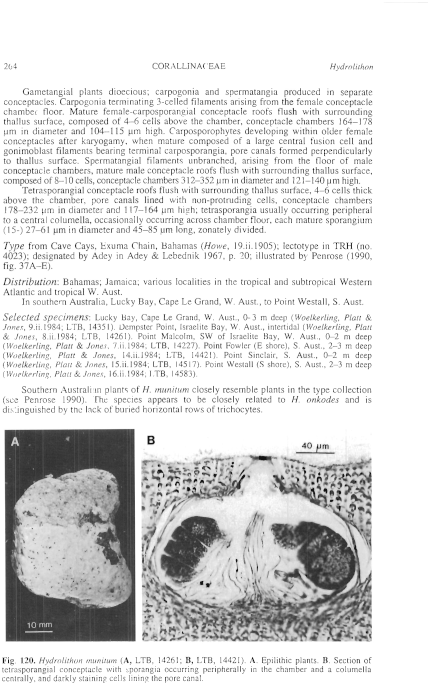|
|
|
|
|
|||||||||||
|
Electronic Flora of South Australia Species Fact Sheet
Phylum Rhodophyta – Class Florideophyceae – Order Corallinales – Family Corallinaceae – Subfamily Mastophoroideae
Synonyms
Lithophyllum munitum Foslie & Howe 1906: 132, pls 86,88,89.
Neogoniolithon munitum (Foslie & Howe) Adey 1970: 9.
Thallus encrusting or warty, up to 20 mm thick, epilithic or epizoic and affixed by cell adhesion. Structure pseudoparenchymatous; organisation dorsiventral; construction monomerous, consisting of a single system of branched filaments that collectively contribute to a ventrally situated core, and a peripheral region where portions of core filaments or their derivatives curve outwards towards the thallus surface; each filament composed of cells 2–11 µm in diameter and 2–25 (–35) µm long; a single epithallial cell terminating most filaments at the thallus surface, distal walls rounded or flattened but not flared; cells of adjacent filaments joined by cell-fusions, secondary pit-connections absent; trichocytes occurring commonly at thallus surface, arranged in vertical rows, horizontal fields or singly, not commonly becoming buried within the thallus.
Reproduction: Vegetative reproduction unknown. Gametangia, carposporangia and tetrasporangia produced in uniporate conceptacles; bisporangia unknown.
Gametangial plants dioecious; carpogonia and spermatangia produced in separate conceptacles. Carpogonia terminating 3-celled filaments arising from the female conceptacle chamber floor. Mature female-carposporangial conceptacle roofs flush with surrounding thallus surface, composed of 4–6 cells above the chamber, conceptacle chambers 164–178 µm in diameter and 104–115 µm high. Carposporophytes developing within older female conceptacles after karyogamy, when mature composed of a large central fusion cell and gonimoblast filaments bearing terminal carposporangia, pore canals formed perpendicularly to thallus surface. Spermatangial filaments unbranched, arising from the floor of male conceptacle chambers, mature male conceptacle roofs flush with surrounding thallus surface, composed of 8–10 cells, conceptacle chambers 312–352 µm in diameter and 121–140 µm high.
Tetrasporangial conceptacle roofs flush with surrounding thallus surface, 4–6 cells thick above the chamber, pore canals lined with non-protruding cells, conceptacle chambers 178–232 µm in diameter and 117–164 µm high; tetrasporangia usually occurring peripheral to a central columella, occasionally occurring across chamber floor, each mature sporangium (15–) 27–61 µm in diameter and 45–85 µm long, zonately divided.
Type from Cave Cays, Exuma Chain, Bahamas (Howe, 19.ii.1905); lectotype in TRH (no. 4023); designated by Adey in Adey & Lebednik 1967, p. 20; illustrated by Penrose (1990, fig. 37A–E).
Selected specimens: Lucky Bay, Cape Le Grand, W. Aust., 0–3 m deep (Woelkerling, Platt & Jones, 9.ii.1984; LTB, 14351). Dempster Point, Israelite Bay, W. Aust., intertidal (Woelkerling, Platt & Jones, 8.ii.1984; LTB, 14261). Point Malcolm, SW of Israelite Bay, W. Aust., 0–2 m deep (Woelkerling, Platt & Jones, 7.ii.1984; LTB, 14227). Point Fowler (E shore), S. Aust., 2–3 m deep (Woelkerling, Platt & Jones, 14.ii.1984; LTB, 14421). Point Sinclair, S. Aust., 0–2 m deep (Woelkerling, Platt & Jones, 15.ii.1984; LTB, 14517). Point Westall (S shore), S. Aust., 2–3 m deep (Woelkerling, Platt & Jones, 16.ii.1984; LTB, 14583).
Distribution: Bahamas; Jamaica; various localities in the tropical and subtropical Western Atlantic and tropical W. Aust.
In southern Australia, Lucky Bay, Cape Le Grand, W. Aust., to Point Westall, S. Aust.
Taxonomic notes: Southern Australian plants of H. munitum closely resemble plants in the type collection (see Penrose 1990). The species appears to be closely related to H. onkodes and is distinguished by the lack of buried horizontal rows of trichocytes.
References:
ADEY, W.H. & LEBEDNIK, P.A. (1967). Catalog of the Foslie Herbarium. (Det Kongelige Norske Videnskabers Selskab Museet: Trondheim, Norway.)
ADEY, W.H. (1970). A revision of the Foslie crustose coralline herbarium. K. norske Vidensk. Selsk. Skr. 1970 (1), 1–46.
FOSLIE, M. & HOWE, M.A. (1906). New American coralline algae. Bull. N.Y. Bot. Gdn 4(13), 128–136, Plates 80–93.
PENROSE, D.L. (1990). Taxonomic studies on Spongites and Neogoniolithon (Corallinaceae, Rhodophyta) in southern Australia. Unpublished PhD Thesis, La Trobe University, Bundoora, Victoria, Australia.
The Marine Benthic Flora of Southern Australia Part IIIB complete list of references.
Publication:
Womersley, H.B.S. (28 June, 1996)
The Marine Benthic Flora of Southern Australia
Rhodophyta. Part IIIB. Gracilarialse, Rhodymeniales, Corallinales and Bonnemaisoniales
Reproduced with permission from The Marine Benthic Flora of Southern Australia Part IIIB 1996, by H.B.S. Womersley. Australian Biological Resources Study, Canberra. Copyright Commonwealth of Australia.
Illustration in Womersley Part IIIA, 1996: FIG. 120.

Figure 120 enlarge
Fig. 120. Hydrolithon munitum (A, LTB, 14261; B, LTB, 14421). A. Epilithic plants. B. Section of tetrasporangial conceptacle with sporangia occurring peripherally in the chamber and a columella centrally, and darkly staining cells lining the pore canal.

|
Email Contact: State Herbarium of South Australia |

|